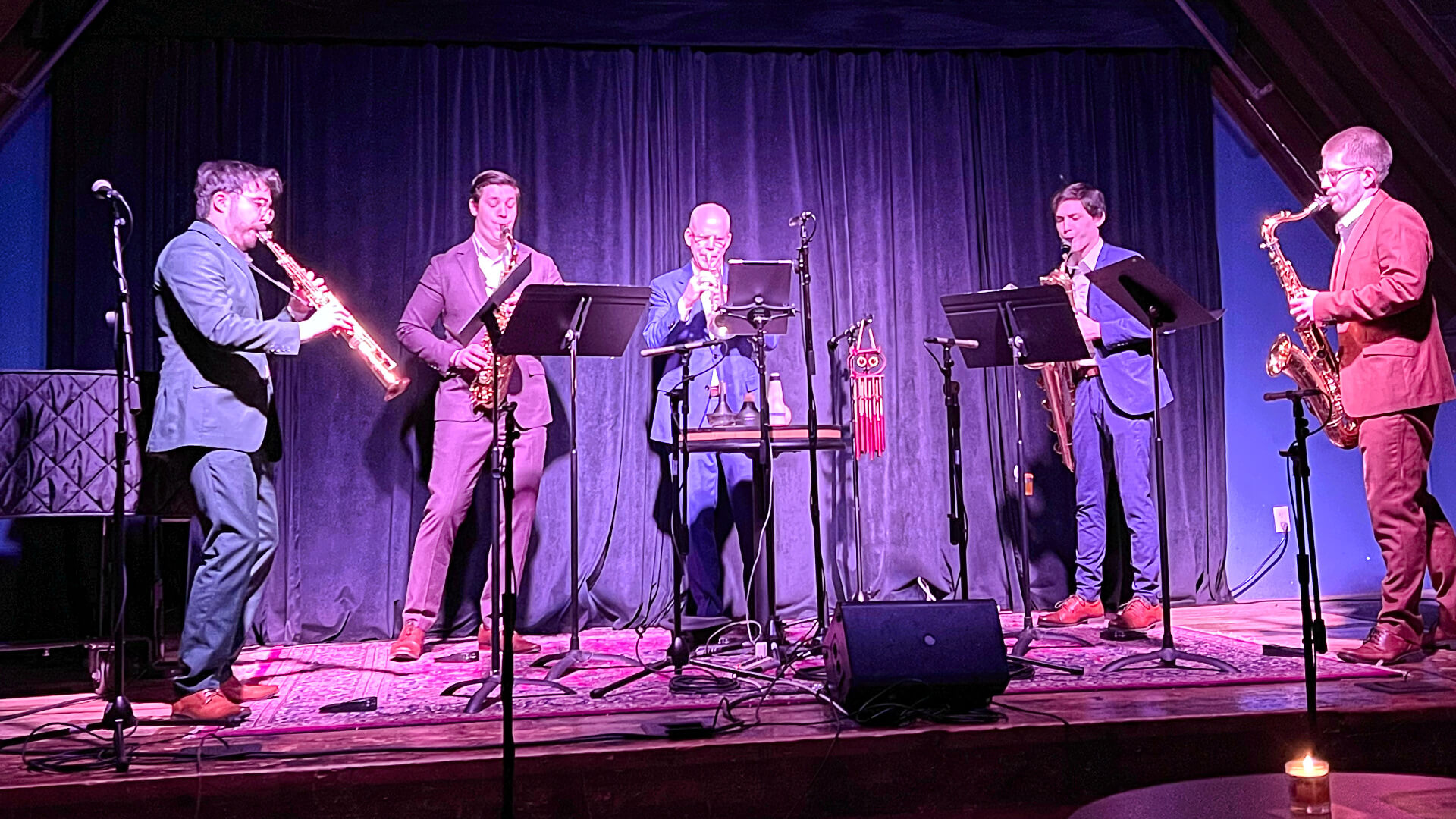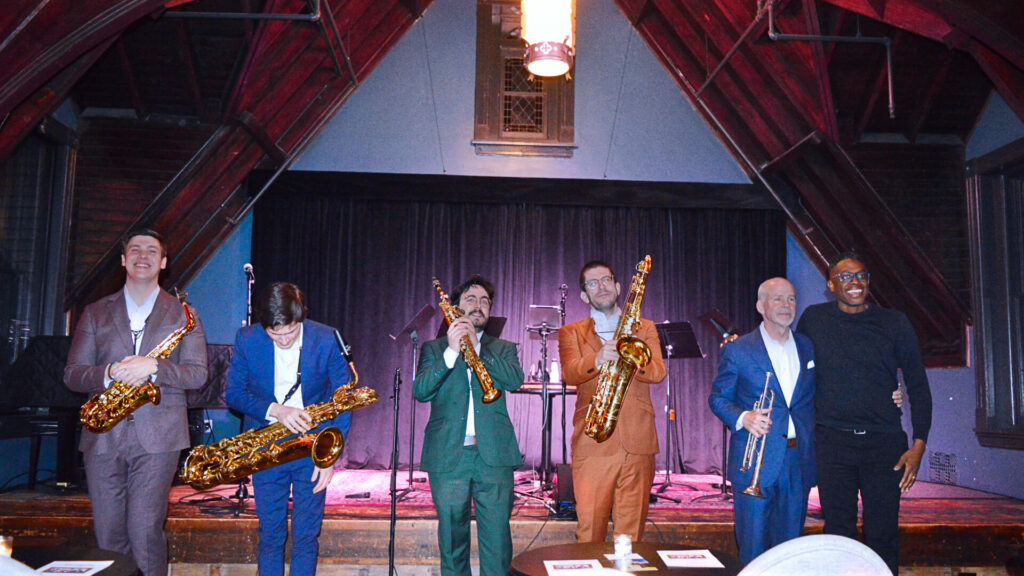
New and Experimental Music,
Art & Technolgy

New and Experimental Music,
Art & Technolgy

The rooftop space of Epiphany Arts Center Sanctuary in Chicago was transformed into a beautiful cabaret ambient last Sunday, February 18. Led by trumpet player Stephen Burns, the Fulcrum Point organization collaborated with the ~Nois Saxophone Quartet to create an intimate atmosphere filled with the captivating sound of brass instruments. The Nois Saxophone quartet, comprised of Hunter Bockes, János Csontos, Jordan Lulloff, and Julian Velasco, has established a strong reputation for performing a distinct repertoire and music composed exclusively for them. The repertoire aligned with the theme of the concert, “Social Sounds,” reflecting Fulcrum Point’s mission to promote new works and contemporary composers while breaking down barriers between religions, classes, ethnicities, races, and sexual orientations. One piece of the program included some unique percussion instruments (wind chimes and ocean drum) and pre-recorded sounds of nature that filled the space, reminding us of nature’s integral role in humanity and the arts.
The concert started with Scott Johnson’s three-movement piece, Raised by Wolves, for trumpet and four saxophones. The first movement, Encounter, starts with long notes in different registers on each instrument. The trumpet adds short jazz passages, and others join in the same way. Throughout all three movements, there is a recurring motif of sustained tones creating cluster chords. This is most noticeable in the first movement, starting softly and building into a powerful chord. All parts contain playful and virtuosic passages, which were performed with clarity and effective articulation. Towards the end, a slow passage brings a mysterious atmosphere.
In the following movement, Acceptance, Scott Johnson creates a lyrical atmosphere where lower and upper instruments engage in an intimate dialogue. This movement is free from any sudden surprises. The composer has skillfully crafted a tranquil progression, with the trumpet and saxophones playing softly, attentively listening to one another, and gracefully taking turns to enhance the leading phrase.
In the final movement, titled Hunt, musicians demonstrate the beatboxing technique and imitate the sound of the drum. While the articulation quality varied throughout the movement, the performers exhibited high virtuosity and solid command of the challenging beatboxing/percussive technique. János Csontos played a slap groove on the baritone sax, replicating the sound of a slapped bass guitar string. Jordan Lulloff and Hunter Bockes masterfully commanded their instruments, making the tenor and alto saxophones imitate guitar timbre. Julian Velasco showcased the captivating sound of the soprano saxophone through several solo parts. Together, the group’s percussive sounds resembled the bass drum, snare drum, and hi-hat disorienting the audiences in their expectations.
Raised by Wolves uses meta-music language, referencing other instruments, genres, and the ambiance of improvisational jazz. The last movement, “Hunt,” captures the musicians’ quest for elusive sounds Johnson envisioned. When the whole band finally kicks in with an electrifying jazz jam session led by a muted trumpet, the audience is transported to an old-school jazz club.
The second piece on the program was Social Sounds from Whales at Night by Emily Doolittle. This composition was originally written in 2007 as an experiment for voice, percussion, and fixed media. It is primarily performed by one musician, and in this case, the voice has been replaced with the trumpet played by Stephen Burnes. In this piece, Burns takes on multiple roles and, along with the pre-recorded loops, brings the audience to various natural sonic environments, such as the jungle, woods, underwater, and even inside a vast tunnel. The dark ambient and industrial drone loops have a high-pitched tone that is reminiscent of the sounds made by whales.
To recreate the sound of the ocean, waves, and the sea world, the piece requires an ocean drum and wind chimes. The ocean drum is played horizontally with both hands, causing the metal beads to roll slowly. Stephen played the ocean drum in perfect harmony with the prerecorded sounds of the natural world. The wood-like sound produced by wind chimes creates a soothing and meditative atmosphere, resembling the minerals and seashells of the ocean world. Burns’s trumpet passages intertwined with the prerecorded high-pitched melodies, creating a spontaneous dialogue-like effect filled with improvisation and virtuosity.
The title of the piece, “Social Sounds from Whales at Night,” is ironic because the music only lets us imagine what we cannot actually experience. Whales use a frequency range of 30 Hz to approximately 8,000 Hz, which surpasses the human hearing range. Still, Doolittle’s piece immerses listeners in a calming and meditative mood. It creates a feeling of being enveloped in soothing music for ears and bodies, where the concepts of space and time lose their significance. It captures the essence of nature and the vastness of the oceanic space, encompassing everything within it.
The concert continued in a similar fashion, with Gemma Peacocke’s piece Dwalm, composed for ~Nois Quartet in 2018. “Dwalm” comes from an old Scottish word and has two meanings; is signifies a stupor or daydream, but also fainting or falling ill. The music reflects this duality, constantly shifting between opposite sides in an attempt to find a focal point.
The composition starts with a mysterious introduction featuring lower notes, foreshadowing unexpected and mystical situations. The sound then transforms into melodic, repetitive patterns exchanged between instruments, gradually increasing in volume and creating a grand sound. Each instrument has a specific role in presenting its repetitive motives. The soprano saxophone part stands out with its notes jumping up and down, and Julian Velasco maintains a steady tempo.
The lyrical tonal oasis is exchanged with short, repetitive motives within a wide range of dynamic nuances. A significant amount of musical material is exchanged in a confined space. The final segment of the piece showcases an expressive and melancholic theme. The short outro closing section delivers an exciting rhythmical effect with all musicians playing a single note in triplets, starting at different times to create a tremolo effect.
The closing piece, Black Music, by Shawn Okpebholo, premiered last Sunday. It was commissioned by Fulcrum Point New Music Project’s Program, which invited unrepresented composers to compose on either the pandemic or social justice and was funded by The Walder Foundation.
The first minute of the first movement, “Black Counterpoint,” gradually builds with references to improvisational free jazz and bebop. Through trumpet leading melody, brass counterpoint, imitation, and passages in unison, the music created a specific cacophony. At times, the phrases come to an abrupt halt, highlighting moments of silence before gradually building up again through crescendo and glissando, culminating in a last cluster chord whose resonance evoked the style of brass and marching band.
With an appealing muffled trumpet sound, Burns began the second movement, “Midnight Hue,” delivering a somber folk tune. This song creates an enigmatic vibe, reminding us of freedom songs, gospel music, or a band playing slow and bluesy melodies late at night. The movement features three different voices. The baritone and alto saxophones establish an ostinato pattern, while the tenor saxophone, soprano saxophone, and trumpet comprise the second group, occasionally breaking into smaller sections and creating an interesting free polyphony. The central theme introduced by the trumpet in the beginning resurfaces when played by the soprano saxophone. Finally, the baritone saxophone takes over in the closing section of the second movement.
The final movement, “Obsidian Glass,” is lively and vibrant, drawing inspiration from the volcanic glass obsidian. It showcases virtuosity and playfulness as each instrument takes turns creating engaging passages. Moments of unity occur when all instruments come together in a structured four-bar sound, followed by a four-bar rest. In the middle section, Okpebholo introduces a lyrical folk-like theme that smoothly transitions into pentatonic scale ostinato patterns until the conclusion.
In a nearly full rooftop venue, Stephen Burns, members of ~Nois Quartet, Shawn Okpebholo, and other featured composers received extended applause. This concert highlights the significance of collaboration between ensembles and organizations, as well as the support musicians receive from institutions like The Walder Foundation. These factors are crucial for both composers and the contemporary music scene.
